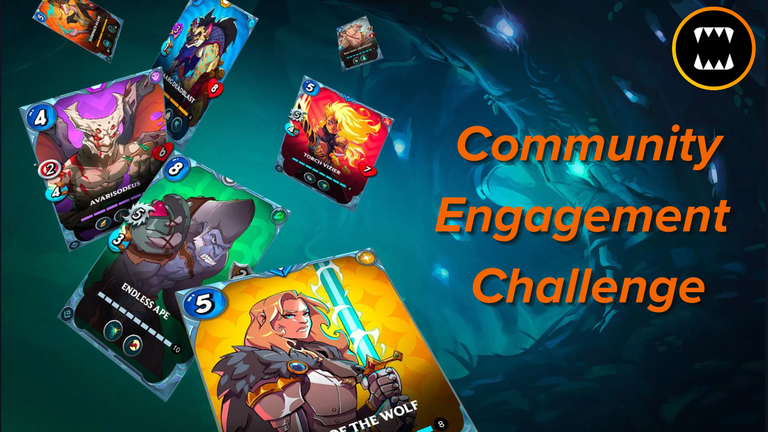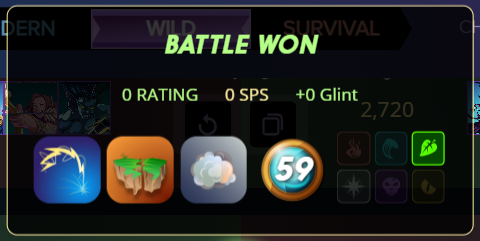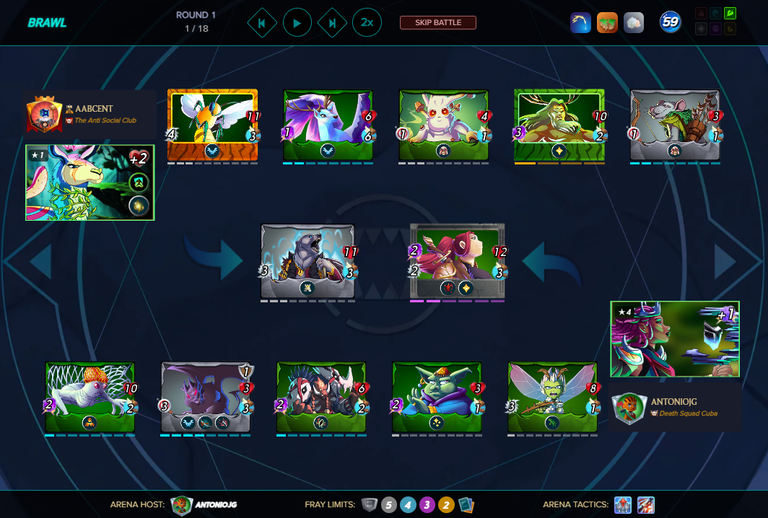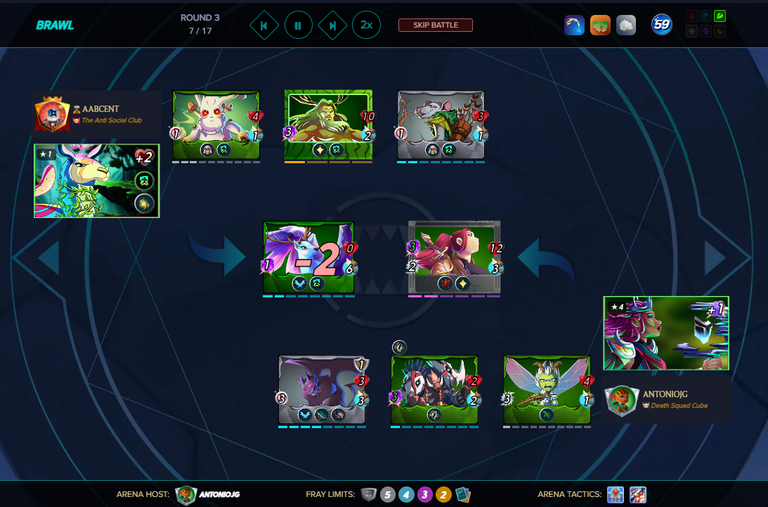Me encanta esta estrategia: Quora Towershead + Taunt + Recharge [Es/En]

Español
¡Saludos comunidad! En el reto de esta semana quiero compartir con ustedes un análisis de mi experiencia utilizando una estrategia con el Splinter de Tierra. La cual considero una excelente opción para aquellas partidas con un límite de maná alto y con las reglas “Earthquake” y “Fog of War”. Es importante recordar que el tipo de ofensiva a utilizar en nuestras estrategias también dependerá del resto de reglas presentes en la batalla.
En esta oportunidad, les mostraré cómo afronté una batalla de Brawl de la liga de Plata en el formato Salvaje, enfocando mi análisis en explicar cómo utilicé al Splinter de Tierra, el anchor Obsidian y a las unidades Quora Towershead, Bramble Pixie, Goblin Psychic, Suidae Shaman, Gargoya Devil y Mycelic Slipspawn para ser coherente con las reglas de batalla presentes y las habilidades que quería combinar con la finalidad de tomar ventaja en la partida con la estrategia planteada.
Ya que estos aspectos son un factor clave con un impacto considerable en el desempeño de nuestras estrategias.

Conjunto de reglas y elección

Hablemos sobre el conjunto de reglas presentes en la batalla, este es el punto de partida para iniciar el análisis que nos llevará a la elección más adecuada para afrontar la batalla.
Límite de maná igual a 59 puntos, esta cantidad nos permite elegir anchors con un costo de maná entre 4 y 7 puntos. Dejándonos con una cantidad de maná restante suficiente para elegir a las unidades adecuadas.
Weak Magic es una regla que tiene como efecto que la magia primero golpee en la armadura antes que en la vida. Por otra parte, Earthquake, hace 2 puntos de daño físico a todas las unidades en cada turno. Mientras que, Fog of War, elimina las habilidades “Snipe”, “Sneak” y “Opportunity” en la batalla.
Entonces, tomando en cuenta todos estos aspectos, utilicé al Splinter de Tierra, ya que cuenta con unidades que poseen buenas estadísticas, entre ellas, un buen ataque mágico, melee y ranged. También cuenta con habilidades como: “Heal”, “Bloodlust”, “Reach”, “Tank Heal”, “Recharge”, “Flying”, “Taunt”, entre otras y con un anchor que incrementa en 1 punto el ataque mágico del equipo.

Equipo y estrategia

Hablemos sobre el equipo y la estrategia que conforma. Dadas las circunstancias, era evidente el uso de cualquier tipo de ataque. Es por ello que decidí utilizar al anchor Obsidian, ya que incrementa en 1 punto el ataque mágico del equipo.
Quora Towershead fue el tanque en esta oportunidad, ya que cuenta con buenas estadísticas, entre ellas, sus puntos de velocidad, vida y ataque mágico y melee. Además, posee las habilidades “Heal” y “Bloodlust”, las cuales le permiten resistir un poco más el daño recibido, e incrementar considerablemente sus estadísticas.
Bramble Pixie apoya al tanque mediante su ataque desde la segunda posición gracias a la habilidad “Reach”. También es importante mencionar que en el caso que nuestro tanque sea abatido, esta unidad tomará la primera posición para dar tiempo al resto del equipo de mantener o tomar la ventaja en la partida.
Goblin Psychic contribuye con su ataque mágico y le da soporte al tanque a través de la habilidad “Tank Heal”.
Suidae Shaman es otra de las unidades clave, ya que hace un daño mágico considerable al enemigo mediante la habilidad “Recharge”. Y este es precisamente uno de los aspectos interesantes de la estrategia.
Gargoya Devil podemos decir que es la unidad de respaldo en la estrategia, ya que dado a su posición estratégica, no recibe daño del enemigo ni de las circunstancias. Además, puede llegar a hacer un daño considerable a través de la habilidad “Deathblow”.
Mycelic Slipspawn es la unidad que permite al tanque resistir un poco más, ya que la misma actúa como carnada, recibiendo todos los ataques del enemigo mediante la habilidad “Taunt”. Esto es otro aspecto clave en la estrategia, ya que le otorga una gran ventaja a nuestro equipo durante la batalla.

Estrategia en acción

Como les mencioné anteriormente, elegir al anchor Obsidian y a las unidades Quora Towershead, Bramble Pixie, Goblin Psychic, Suidae Shaman, Gargoya Devil y Mycelic Slipspawn, fue una buena opción. Sin embargo, también es importante incluir habilidades de soporte que le permitan a nuestro tanque y al resto del equipo, resistir lo suficiente.
Observen como para el turno 7 de la ronda 3, el equipo enemigo estaba casi abatido. Quora Towershead y Bramble Pixie lo hicieron muy bien en sus posiciones. De igual manera, Suidae Shaman y Gargoya Devil. Por lo que podemos decir satisfactoriamente que el sacrificio de Mycelic Slipspawn y Goblin Psychic, valió la pena. También me gustaría destacar que como pudieron observar, no todas las unidades que utilicé tenían la habilidad “Flying” y aún así, la estrategia funcionó como se esperaba.
Si quieres ver la batalla completa, acá te dejo el enlace: CLIC PARA VER LA BATALLA

Conclusión
La estrategia planteada hizo un uso eficiente de la cantidad de maná disponible, cubriendo aspectos tales como: resistencia contra el daño enemigo, soporte del equipo, una buena ofensiva, y coherencia con el conjunto de reglas presente.
Una debilidad de esta estrategia es un equipo enemigo que cuente con resistencia a los ataques mágicos y físicos, e incluya habilidades como: “Void”, “Phase”, “Tank Heal”, “Heal”, “Triage”, “Silence”, “Magic Reflect”, “Amplify”, “Shield”, “Protect”, “Repair”, “Headwinds”, “Demoralize”, entre otras.
La diferencia entre las estrategias fue que el equipo enemigo no contaba con las habilidades de soporte suficientes para resistir el daño de mi equipo y el de las circunstancias.
Para el funcionamiento adecuado de nuestras estrategias, es importante considerar todos los aspectos involucrados, por lo que no sólo debemos enfocarnos en las estadísticas y habilidades a combinar. También debemos tener en cuenta la influencia de los conjuntos de reglas sobre la estrategia.
Este ha sido mi aporte al desafío semanal, ¡Espero haya sido de su agrado! ¡Saludos y hasta la próxima semana!

English
Greetings, community! In this week's challenge, I want to share with you an analysis of my experience using a strategy with Earth Splinter. I consider this an excellent option for games with a high mana limit and with the “Earthquake” and “Fog of War” rules. It is important to remember that the type of offense to use in our strategies will also depend on the other rules present in the battle.
This time, I'll show you how I approached a Silver league Brawl battle in the Wild format, focusing my analysis on explaining how I used Earth Splinter, the Obsidian anchor, and the units Quora Towershead, Bramble Pixie, Goblin Psychic, Suidae Shaman, Gargoyle Devil, and Mycelic Slipspawn to be consistent with the battle rules and the abilities I wanted to combine in order to take advantage of the game with the proposed strategy.
These aspects are a key factor with a considerable impact on the performance of our strategies.

Rulesets and choise

Let's talk about the set of rules present in battle. This is the starting point for the analysis that will lead us to the most appropriate choice for facing battle.
The mana limit is 59 points, which allows us to choose anchors with a mana cost between 4 and 7 points. This leaves us with enough mana remaining to choose the right units.
Weak Magic is a rule that causes magic to hit armor before life. On the other hand, Earthquake does 2 points of physical damage to all units each turn. Meanwhile, Fog of War removes the “Snipe,” “Sneak,” and “Opportunity” abilities in battle.
So, taking all these aspects into account, I used the Earth Splinter, as it has units with good stats, including good magic, melee, and ranged attacks. It also has abilities such as “Heal,” “Bloodlust,” “Reach,” “Tank Heal,” “Recharge,” “Flying,” “Taunt,” among others, and an anchor that increases the team's magic attack by 1 point.

Team and strategy

Let's talk about the team and the strategy it forms. Given the circumstances, it was clear that any type of attack would be used. That's why I decided to use the anchor Obsidian, as it increases the team's magic attack by 1 point.
Quora Towershead was the tank this time, as it has good stats, including speed, health, and magic and melee attack points. In addition, he has the “Heal” and “Bloodlust” abilities, which allow him to withstand damage a little longer and significantly increase his stats.
Bramble Pixie supports the tank by attacking from the second position thanks to the “Reach” ability. It is also important to mention that if our tank is defeated, this unit will take the first position to give the rest of the team time to maintain or take the advantage in the game.
Goblin Psychic contributes with his magic attack and supports the tank through the “Tank Heal” skill.
Suidae Shaman is another key unit, as it deals considerable magical damage to the enemy with the “Recharge” ability. And this is precisely one of the interesting aspects of the strategy.
Gargoya Devil can be said to be the backup unit in the strategy, as given its strategic position, it does not take damage from the enemy or the circumstances. In addition, it can do considerable damage through the “Deathblow” skill.
Mycelic Slipspawn is the unit that allows the tank to resist a little longer, as it acts as bait, receiving all enemy attacks through the “Taunt” skill. This is another key aspect of the strategy, as it gives our team a great advantage during battle.

Strategy in action

As I mentioned earlier, choosing the Obsidian anchor and the Quora Towershead, Bramble Pixie, Goblin Psychic, Suidae Shaman, Gargoyle Devil, and Mycelic Slipspawn units was a good choice. However, it is also important to include support abilities that allow our tank and the rest of the team to withstand enough damage.
Notice how by turn 7 of round 3, the enemy team was almost defeated. Quora Towershead and Bramble Pixie did very well in their positions. Likewise, Suidae Shaman and Gargoya Devil. So we can safely say that the sacrifice of Mycelic Slipspawn and Goblin Psychic was worth it. I would also like to point out that, as you can see, not all the units I used had the “Flying” ability, and yet the strategy worked as expected.
If you want to see the complete battle, here you have the link: CLICK TO WATCH THE BATTLE

Conclusion
The proposed strategy made efficient use of the available mana, covering aspects such as: resistance to enemy damage, team support, a good offense, and consistency with the current set of rules.
A weakness of this strategy is an enemy team that has resistance to magical and physical attacks and includes abilities such as: “Void,” “Phase,” “Tank Heal,” “Heal,” “Triage,” “Silence,” “Magic Reflect,” “Amplify,” “Shield,” “Protect,” “Repair,” “Headwinds,” “Demoralize,” among others.
The difference between the strategies was that the enemy team did not have enough support abilities to withstand the damage from my team and the circumstances.
For our strategies to work properly, it is important to consider all aspects involved, so we should not only focus on the statistics and skills to combine. We must also take into account the influence of the rule sets on the strategy.
This has been my contribution to the weekly challenge. I hope you enjoyed it! Greetings and see you next week!

Te invito a seguirme en / I invite you to follow me on: Twitter
Las traducciones fueron realizadas con el traductor / Translations were done with the translator: DeepL
Todas las imágenes fueron tomadas de / and all images were taken from: Splinterlands

https://x.com/AntonioJGB92/status/1941263052332290386
Thanks for sharing! - @clove71

¡Gracias! | Thanks! ✌️